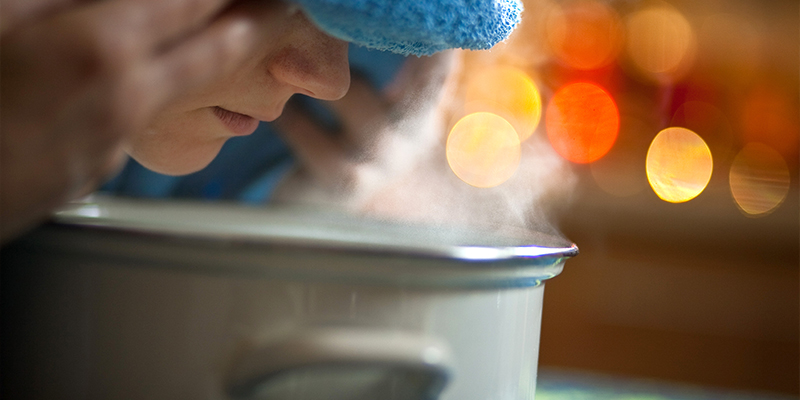As you lay in bed, tossing and turning, your stuffed-up nose preventing any hope of sleep, you wonder if there’s any way to find relief. That can be a real pain in our, well, nose. Whether it’s from a cold, allergies, or just general congestion, having a blocked nose can make it feel like you’re breathing through a straw.
Thankfully, there is a simple and natural remedy that can help to ease the symptoms and provide much-needed relief. Steam inhalation, a centuries-old practice that has stood the test of time. By harnessing the power of steam, you can open up your blocked airways. In this blog post, we’ll walk you through the ins and outs of steam inhalation, so you can say goodbye to your congestion and hello to relief.
How to Perform Steam Inhalation for a Blocked Nose

Here are the steps to follow when performing steam inhalation for a blocked nose:
Step 1: Boil Water
Fill in a big pot with water and allow it to boil. You may also boil the water using an electric kettle.
Step 2: Add herbs or essential oils (optional)
For additional advantages, you can add herbs or essential oils to the water. Eucalyptus oil, peppermint oil, and chamomile are a few excellent alternatives. Simply add a few drops of the oil to the water and stir.
Step 3: Lower the Temperature
After the water has boiled, take the vessel from the burner and set it aside for a minute or two. This will bring the water temperature down to a safe level.
Step 4: Position your face over the steam.
Pour the water into a bowl when it has somewhat cooled. Place the bowl on a table or other flat surface and take a seat in front of it. Make sure that your face is at a comfortable distance from the bowl and that you can readily inhale the steam.
Step 5: Cover your head with a towel.
To make the steam inhalation more effective, cover your head with a towel. This will assist in trapping the steam and directing it towards your face. Make sure the towel covers your head and the bowl, creating a tent-like shape.
Step 6: Inhale deeply
Once you’re in position, take a deep breath through your nose. Try to breathe in as deeply as possible and hold the steam in your lungs for a few seconds. Then exhale slowly through your mouth. Continue to inhale and exhale deeply for 5-10 minutes.
Step 7: Take a Break
Take a break every few minutes to avoid feeling dizzy or lightheaded. You can also lift the towel to let in the fresh air.
Benefits of Steam Inhalation for a Blocked Nose
Steam inhalation is a natural remedy that has been used for centuries to treat various respiratory conditions. It provides the following benefits:
- Relieves Nasal Congestion: Steam inhalation helps to open up the nasal passages, allowing you to breathe easier. It also thins the mucus in your nose and throat, making it easier to expel.
- Soothes Dry Throat: The warm, moist air from steam inhalation helps to soothe a dry and irritated throat, reducing cough and throat pain.
- Helps to Moisturize Dry Skin: Steam inhalation can also help moisturize dry skin, which may be caused by cold, dry air.
Precautions to Take When Performing Steam Inhalation
- Don’t Burn Yourself:
Make sure the water isn’t overly hot, as this might result in burns. Test the water temperature with your hand before performing steam inhalation.
2 Don’t Overdo It:

Don’t perform steam inhalation for longer than 10 minutes at a time. Taking breaks every few minutes can help prevent dizziness and light headedness.
3. Avoid Using Essential Oils If You Have Allergies:
If you have allergies, using essential oils may trigger an allergic reaction. Before using essential oils, it is advised that you consult with your doctor.
Conclusion
In conclusion, steam inhalation is a simple, natural, and effective remedy for a blocked nose that has been used for centuries. By following the steps outlined in this blog post, you can harness the power of steam to relieve your nasal congestion, soothe your dry throat, and moisturize your dry skin. However, it’s important to take precautions to avoid burns, dizziness, and allergic reactions. So, the next time you’re tossing and turning with a blocked nose, give steam inhalation a try and breathe easier.



